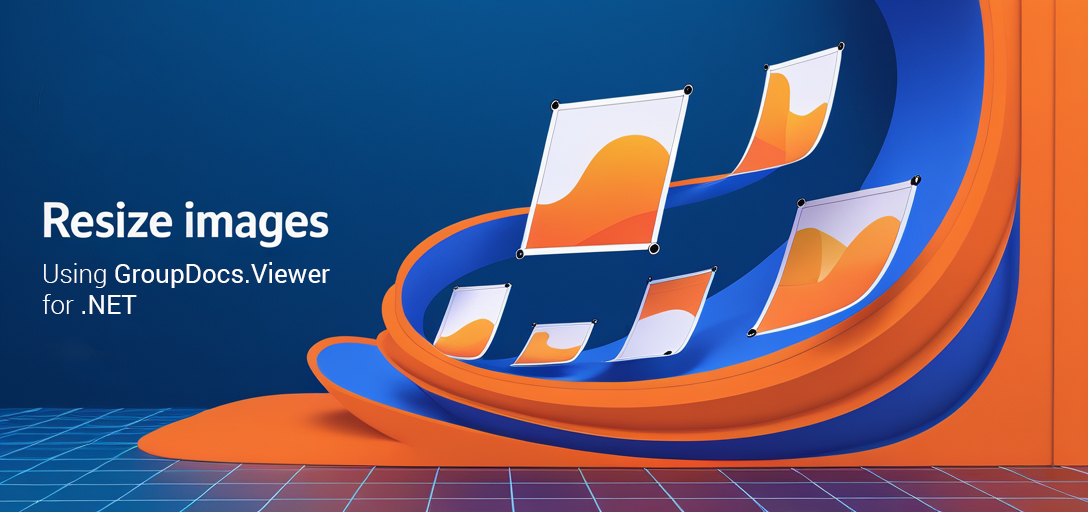How to Resize Images with GroupDocs.Viewer .NET: A Step-by-Step Guide for Developers
Introduction
Are you looking to resize images generated from documents to meet specific design requirements or optimize them for web display? With GroupDocs.Viewer for .NET, resizing images is straightforward and efficient. This tutorial guides developers in leveraging GroupDocs.Viewer’s capabilities to adjust image dimensions effectively.

What You’ll Learn:
- How to set up and initialize GroupDocs.Viewer for .NET
- Steps to resize images using viewer features
- Common pitfalls and troubleshooting tips
- Real-world applications of image resizing
Let’s start with the prerequisites needed before diving in.
Prerequisites
Before beginning, ensure you have:
Required Libraries and Versions
- GroupDocs.Viewer for .NET: Version 25.3.0 or later.
Environment Setup Requirements
- A compatible .NET environment (e.g., .NET Core or .NET Framework).
- Visual Studio or any preferred IDE supporting C# development.
Knowledge Prerequisites
- Basic understanding of C# programming and file I/O operations in .NET.
- Familiarity with NuGet package management for adding libraries to your project.
With these prerequisites covered, let’s move on to setting up GroupDocs.Viewer for .NET.
Setting Up GroupDocs.Viewer for .NET
To start using GroupDocs.Viewer, install it via a package manager. This can be done through either the NuGet Package Manager Console or the .NET CLI:
NuGet Package Manager Console
Install-Package GroupDocs.Viewer -Version 25.3.0
.NET CLI
dotnet add package GroupDocs.Viewer --version 25.3.0
License Acquisition
GroupDocs.Viewer offers a free trial for initial testing, allowing exploration of its features without cost. For prolonged use or commercial purposes, acquiring a temporary license or purchasing the software is recommended.
To obtain a free trial, visit GroupDocs Free Trial. If you require extended access, consider obtaining a temporary license from GroupDocs Temporary License or purchase directly via their Purchase Page.
Basic Initialization
Here’s how to initialize GroupDocs.Viewer in your C# project:
using System.IO;
using GroupDocs.Viewer;
using GroupDocs.Viewer.Options;
string outputDirectory = Path.Combine("YOUR_OUTPUT_DIRECTORY");
string pageFilePathFormat = Path.Combine(outputDirectory, "page_{0}.jpg");
// Initialize the Viewer object with a document path.
using (Viewer viewer = new Viewer(@"YOUR_DOCUMENT_DIRECTORY/SAMPLE_DOCX"))
{
// Setup and create an instance of JpgViewOptions.
JpgViewOptions options = new JpgViewOptions(pageFilePathFormat);
}
In this snippet, we initialize the Viewer object with a specific document path and configure output settings using JpgViewOptions.
Implementation Guide
Let’s explore how to resize images generated from documents using GroupDocs.Viewer. We will break down the process into clear steps for easy understanding.
Adjusting Image Size
This feature lets you customize image dimensions according to your requirements, whether for web optimization or specific display settings.
Step 1: Initialize Viewer and Set Output Format
First, set up your environment with necessary paths and initialize the Viewer object:
using (Viewer viewer = new Viewer(@"YOUR_DOCUMENT_DIRECTORY/SAMPLE_DOCX"))
{
JpgViewOptions options = new JpgViewOptions(pageFilePathFormat);
}
Step 2: Configure Image Dimensions
Set the desired width and height for your output images:
options.Width = 600; // Set the width of the image.
options.Height = 800; // Set the height of the image.
Step 3: Render the Document as Images
Use the viewer.View(options) method to process and render your document into images with specified dimensions:
viewer.View(options);
Key Configuration Options:
- Width & Height: Define pixel dimensions of output images.
- Output Path Format: Customize file saving locations.
Troubleshooting Tips:
- Ensure paths to documents and output directories exist and are correctly configured.
- Check for sufficient permissions if writing to a specific directory.
Practical Applications
Understanding practical applications can help contextualize the benefits of image resizing. Here are some real-world use cases:
- Web Optimization: Resize images to ensure faster load times on websites, enhancing user experience.
- Document Presentation: Tailor document previews for presentations or reports with specific size requirements.
- Archiving and Storage: Optimize storage space by adjusting image sizes before archiving digital documents.
Integration possibilities include combining GroupDocs.Viewer with other .NET systems like ASP.NET applications or using it alongside frameworks that handle media manipulation.
Performance Considerations
When working with large documents, consider these performance optimization strategies:
- Batch Processing: Handle multiple images in batches to reduce memory load.
- Efficient Resource Management: Release resources promptly after processing each document page.
Best Practices:
- Use appropriate image resolutions based on the end-use case to balance quality and performance.
- Monitor application memory usage, especially when dealing with high-resolution documents.
Conclusion
This tutorial covered how to effectively resize images using GroupDocs.Viewer for .NET. By following these steps, you can ensure your document images meet specific size requirements, optimizing them for various applications.
Next Steps
Explore further customization options and advanced features available in the GroupDocs.Viewer library. Experiment with different image formats or integrate viewer capabilities into larger application workflows.
Call-to-Action: Try implementing this solution in your next project to experience firsthand how easily you can manage document images with GroupDocs.Viewer for .NET.
FAQ Section
- What is GroupDocs.Viewer?
- A comprehensive library for viewing and managing documents within .NET applications.
- Can I resize PDFs using GroupDocs.Viewer?
- Yes, the viewer supports various document formats including PDFs.
- Is resizing images resource-intensive?
- It depends on the image size and resolution; however, GroupDocs.Viewer is optimized for efficient processing.
- How do I handle large documents efficiently?
- Consider processing in batches and managing resources effectively as outlined above.
- What are some common issues with GroupDocs.Viewer?
- Ensure all paths are correctly set and permissions are granted to avoid file access errors.